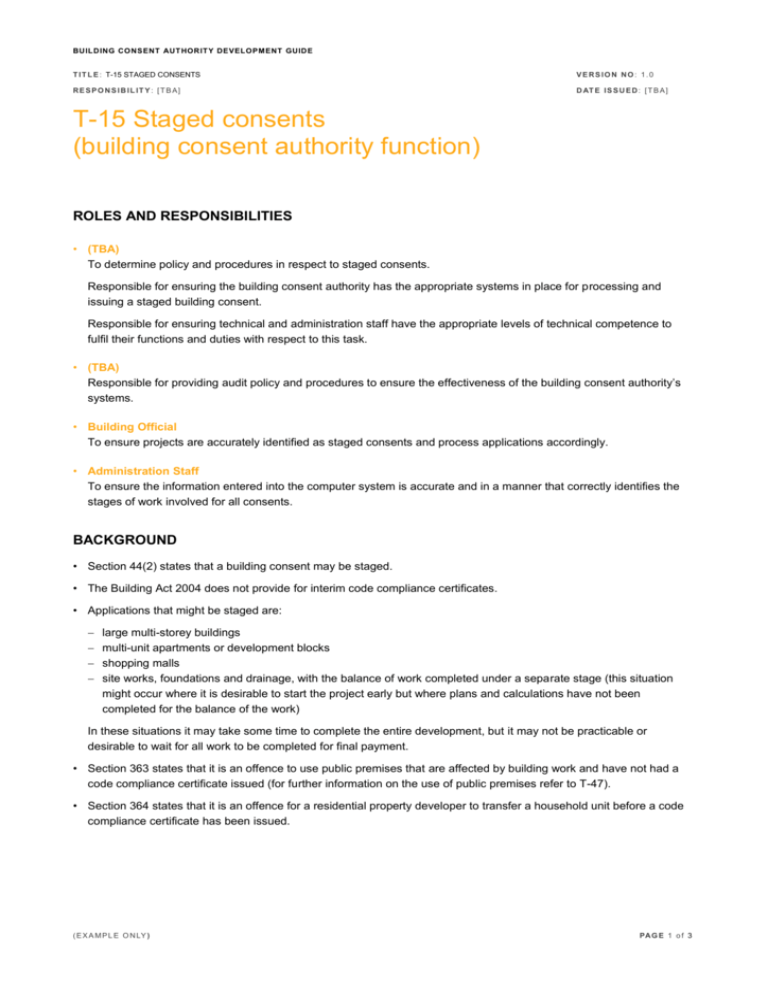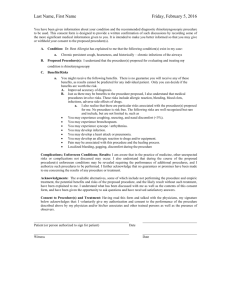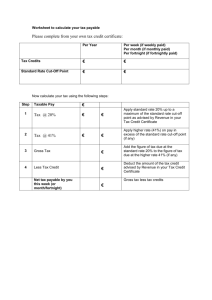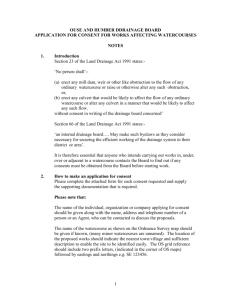T-15 Staged consents (building consent authority function)
advertisement

BUILDING CO NSENT AUT HORIT Y DEVELOPMENT GUIDE T I T L E : T-15 STAGED CONSENTS VE RS IO N NO : 1.0 RE SPO NS IB IL IT Y: [TB A] D AT E I S S U E D : [ T B A ] T-15 Staged consents (building consent authority function) ROLES AND RESPONSIBILITIES • (TBA) To determine policy and procedures in respect to staged consents. Responsible for ensuring the building consent authority has the appropriate systems in place for processing and issuing a staged building consent. Responsible for ensuring technical and administration staff have the appropriate levels of technical competence to fulfil their functions and duties with respect to this task. • (TBA) Responsible for providing audit policy and procedures to ensure the effectiveness of the building consent authority’s systems. • Building Official To ensure projects are accurately identified as staged consents and process applications accordingly. • Administration Staff To ensure the information entered into the computer system is accurate and in a manner that correctly identifies the stages of work involved for all consents. BACKGROUND • Section 44(2) states that a building consent may be staged. • The Building Act 2004 does not provide for interim code compliance certificates. • Applications that might be staged are: large multi-storey buildings multi-unit apartments or development blocks shopping malls site works, foundations and drainage, with the balance of work completed under a separate stage (this situation might occur where it is desirable to start the project early but where plans and calculations have not been completed for the balance of the work) In these situations it may take some time to complete the entire development, but it may not be practicable or desirable to wait for all work to be completed for final payment. • Section 363 states that it is an offence to use public premises that are affected by building work and have not had a code compliance certificate issued (for further information on the use of public premises refer to T-47). • Section 364 states that it is an offence for a residential property developer to transfer a household unit before a code compliance certificate has been issued. ( E X A M P L E O N LY ) PAG E 1 o f 3 BUILDING CO NSENT AUT HORIT Y DEVELOPMENT GUIDE T I T L E : T-15 STAGED CONSENTS VE RS IO N NO : 1.0 RE SPO NS IB IL IT Y: [TB A] D AT E I S S U E D : [ T B A ] PROCEDURE 1 EXPLAIN PROCESS TO CUSTOMER It is best to explain the following to the customer at the beginning of the project: 1.1 In the case of public premises: Premises can not be used by the public without a code compliance certificate or certificate for public use. It is an offence to permit the use of the premises intended for public use (refer to T-33 and T-47). In these situations it may be preferable to stage the consents so that some parts of the building can be completed, issued with a code compliance certificate and therefore be used. 1.2 In the case of a residential property developer: Where the application involves building more than one household unit, it may be preferable for the developer to stage consents so a code compliance certificate can be obtained for each unit. 1.3 In other cases: The decision to stage the consent will depend on financial or other considerations such as timing, costs, etc. 2 ASSESS APPLICATION TO DETERMINE SCOPE OF WORK 2.1 Clearly identify the number of proposed stages. 2.2 Ensure data entry correctly identifies that this is a staged consent. 2.3 Clearly identify the nature of work involved, for example, foundations and drainage only. 3 ASSESS BUILDING COSTS 3.1 Determine value of building work. 3.2 If this is the first stage and the value of the building work is less than $20,000, no Department of Building and Housing levy is payable. 3.3 If this is the first stage and the value of the building work is more than $20,000, assess the Department of Building and Housing levy accordingly. 3.4 If this is the second stage and the value of the first stage was less than $20,000, add the value of the first stage to the second stage to determine fee payable (fee is cumulative). 3.5 If this is the second stage and the value of the first stage was more than $20,000 but the value of the second stage is less than $20,000, calculate fees based on value of second stage. Example 1: Stage 1 Foundations and drainage, building value $18,000 (No fee payable) Stage 2 Balance of work, building value $180,000 Fee payable on Stage 1 plus Stage 2, building value $198,000 Fee charged at Stage 2 ( E X A M P L E O N LY ) PAG E 2 o f 3 BUILDING CO NSENT AUT HORIT Y DEVELOPMENT GUIDE T I T L E : T-15 STAGED CONSENTS VE RS IO N NO : 1.0 RE SPO NS IB IL IT Y: [TB A] D AT E I S S U E D : [ T B A ] Example 2: Stage 1 New Dwelling excluding drainage $180,000 (Fee payable on $180,000) Stage 2 Drainage building value $18,000 (Fee payable on $18,000) In both scenarios the total value of building work was $198,000, which is the figure the levy should be based on. 4 ASSESS PLANS 4.1 Assess the plans to ensure only the building work that is to be covered by the staged consent is included on the consent plans. 4.2 This is important because a code compliance certificate can only be issued against the consent plans. 5 CHECK FOR OUTSTANDING CODE COMPLIANCE CERTIFICATES 5.1 If this is the second or subsequent stage, check to ensure previous stages are complete and, where possible, issue with a code compliance certificate. 6 PROCESS APPLICATION 6.1 Continue processing application in normal manner (refer to T-19). NOTES ( E X A M P L E O N LY ) PAG E 3 o f 3








